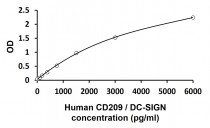ARG81615
Human CD209 / DC-SIGN ELISA Kit
Human CD209 / DC-SIGN ELISA Kit for ELISA and Human
Component
| Cat No | Component Name | Package | Temp |
|---|---|---|---|
| ARG81615-001 | Antibody-coated microplate | 8 X 12 strips | 4°C. Unused strips should be sealed tightly in the air-tight pouch. |
| ARG81615-002 | Standard | 2 X 10 ng/vial | 4°C |
| ARG81615-003 | Standard/Sample diluent | 30 ml (Ready to use) | 4°C |
| ARG81615-004 | Antibody conjugate concentrate (100X) | 1 vial (100 µl) | 4°C |
| ARG81615-005 | Antibody diluent buffer | 12 ml (Ready to use) | 4°C |
| ARG81615-006 | HRP-Streptavidin concentrate (100X) | 1 vial (100 µl) | 4°C |
| ARG81615-007 | HRP-Streptavidin diluent buffer | 12 ml (Ready to use) | 4°C |
| ARG81615-008 | 25X Wash buffer | 20 ml | 4°C |
| ARG81615-009 | TMB substrate | 10 ml (Ready to use) | 4°C (Protect from light) |
| ARG81615-010 | STOP solution | 10 ml (Ready to use) | 4°C |
| ARG81615-011 | Plate sealer | 4 strips | Room temperature |
Overview
| Product Description | ARG81615 Human CD209 / DC-SIGN ELISA Kit is an Enzyme Immunoassay kit for the quantification of Human CD209 / DC-SIGN in serum, plasma (heparin, EDTA) and cell culture supernatants. |
|---|---|
| Tested Reactivity | Hu |
| Tested Application | ELISA |
| Specificity | There is no detectable cross-reactivity with other relevant proteins. |
| Target Name | CD209 / DC-SIGN |
| Conjugation | HRP |
| Conjugation Note | Substrate: TMB and read at 450 nm. |
| Sensitivity | 46.85 pg/ml |
| Sample Type | Serum, plasma (heparin, EDTA) and cell culture supernatants. |
| Standard Range | 93.7 - 6000 pg/ml |
| Sample Volume | 100 µl |
| Precision | Intra-Assay CV: 4.4% Inter-Assay CV: 5.3% |
| Alternate Names | CDSIGN; Dendritic cell-specific ICAM-3-grabbing non-integrin 1; CLEC4L; DC-SIGN; CD antigen CD209; CD209 antigen; DC-SIGN1; C-type lectin domain family 4 member L |
Application Instructions
| Assay Time | ~ 5 hours |
|---|
Properties
| Form | 96 well |
|---|---|
| Storage Instruction | Store the kit at 2-8°C. Keep microplate wells sealed in a dry bag with desiccants. Do not expose test reagents to heat, sun or strong light during storage and usage. Please refer to the product user manual for detail temperatures of the components. |
| Note | For laboratory research only, not for drug, diagnostic or other use. |
Bioinformation
| Database Links | |
|---|---|
| Gene Symbol | CD209 |
| Gene Full Name | CD209 molecule |
| Background | This gene encodes a transmembrane receptor and is often referred to as DC-SIGN because of its expression on the surface of dendritic cells and macrophages. The encoded protein is involved in the innate immune system and recognizes numerous evolutionarily divergent pathogens ranging from parasites to viruses with a large impact on public health. The protein is organized into three distinct domains: an N-terminal transmembrane domain, a tandem-repeat neck domain and C-type lectin carbohydrate recognition domain. The extracellular region consisting of the C-type lectin and neck domains has a dual function as a pathogen recognition receptor and a cell adhesion receptor by binding carbohydrate ligands on the surface of microbes and endogenous cells. The neck region is important for homo-oligomerization which allows the receptor to bind multivalent ligands with high avidity. Variations in the number of 23 amino acid repeats in the neck domain of this protein are rare but have a significant impact on ligand binding ability. This gene is closely related in terms of both sequence and function to a neighboring gene (GeneID 10332; often referred to as L-SIGN). DC-SIGN and L-SIGN differ in their ligand-binding properties and distribution. Alternative splicing results in multiple variants.[provided by RefSeq, Feb 2009] |
| Function | Pathogen-recognition receptor expressed on the surface of immature dendritic cells (DCs) and involved in initiation of primary immune response. Thought to mediate the endocytosis of pathogens which are subsequently degraded in lysosomal compartments. The receptor returns to the cell membrane surface and the pathogen-derived antigens are presented to resting T-cells via MHC class II proteins to initiate the adaptive immune response. Probably recognizes in a calcium-dependent manner high mannose N-linked oligosaccharides in a variety of pathogen antigens, including HIV-1 gp120, HIV-2 gp120, SIV gp120, ebolavirus glycoproteins, cytomegalovirus gB, HCV E2, dengue virus gE, Leishmania pifanoi LPG, Lewis-x antigen in Helicobacter pylori LPS, mannose in Klebsiella pneumonae LPS, di-mannose and tri-mannose in Mycobacterium tuberculosis ManLAM and Lewis-x antigen in Schistosoma mansoni SEA. On DCs it is a high affinity receptor for ICAM2 and ICAM3 by binding to mannose-like carbohydrates. May act as a DC rolling receptor that mediates transendothelial migration of DC presursors from blood to tissues by binding endothelial ICAM2. Seems to regulate DC-induced T-cell proliferation by binding to ICAM3 on T-cells in the immunological synapse formed between DC and T-cells. [UniProt] |
| Highlight | Related products: CD209 antibodies; CD209 ELISA Kits; New ELISA data calculation tool: Simplify the ELISA analysis by GainData |
Images (1) Click the Picture to Zoom In
| Title | Download Link |
|---|---|
| ARG81615 Human CD209 / DC-SIGN ELISA Kit user's manual |
 Download Download
|






